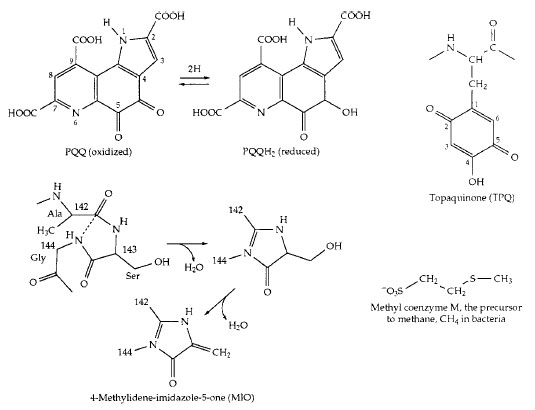Recently Discovered Coenzymes and Prosthetic Groups
While all of the vitamins may have been discovered, new catalytic cofactors and prosthetic groups are still being found. They are too numerous to mention. A few are shown in Fig. 23. The coenzyme PQQ is a hydrogen carrier that replaces NAD in certain bacterial alcohol dehydrogenases. Topaquinone is a cofactor for amino oxidases found in bacterial, plant, and human tissues. It is a prosthetic group that is formed by oxidation of a specific tyrosine in the active site. It functions together with a nearby copper ion which binds the O2 substrate. The same copper center and O2 are apparently involved in the spontaneous synthesis of the prosthetic group. Formation of topaquinone is only one case of many, in which prosthetic groups are self-assembled using components of the protein that carries the group. Another recently discovered example is formation of 4-methylidene-imidazole-5-one (MIO), from glycine and serine units of a protein. The prosthetic group is involved in a previously hard-to-explain isomerization of histidine and phenylalanine. A parallel reaction with phenylalanine initiates the major pathway of synthesis of thousands of aromatic compounds in plants.Among specialized coenzymes are a collection of compounds (which include the previously mentioned methanopterin) needed by methane-forming bacteria and compounds such as the light-emitting luciferin of fireflies. Luminous jellyfish make different light-emitting compounds which, like topaquinone and MIO are made from side chains of amino acids. The list could be continued for pages.





